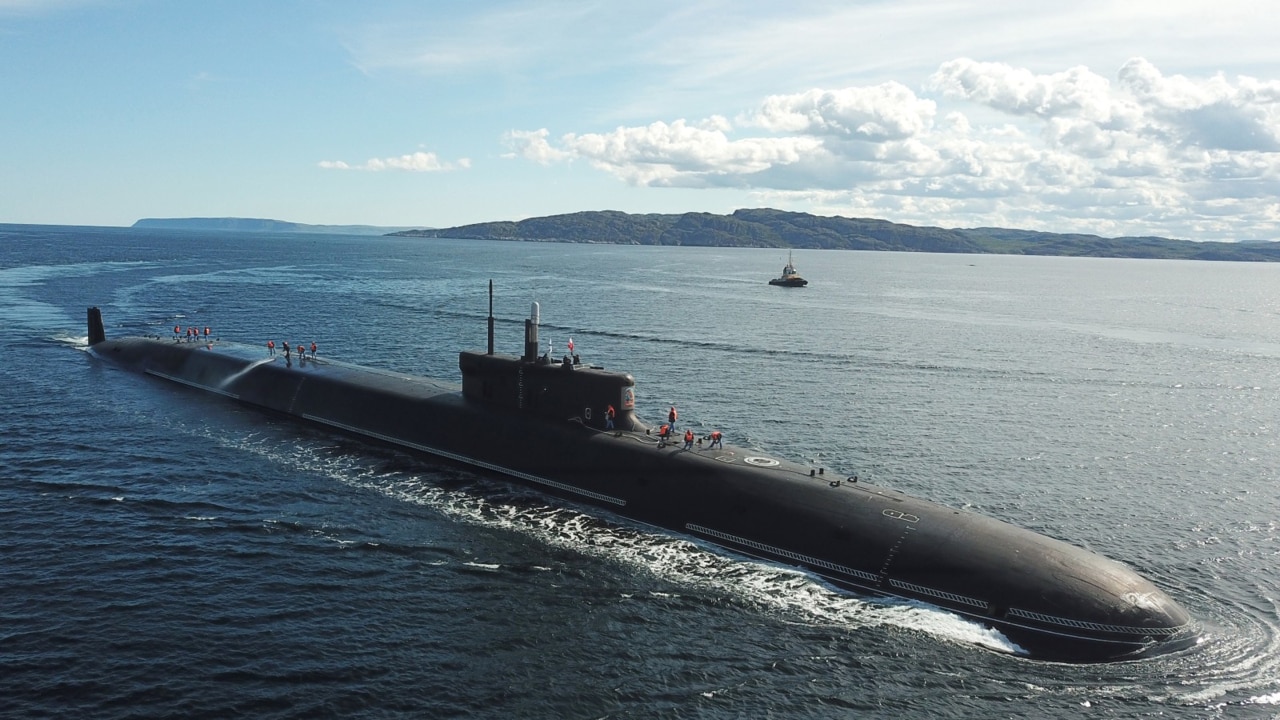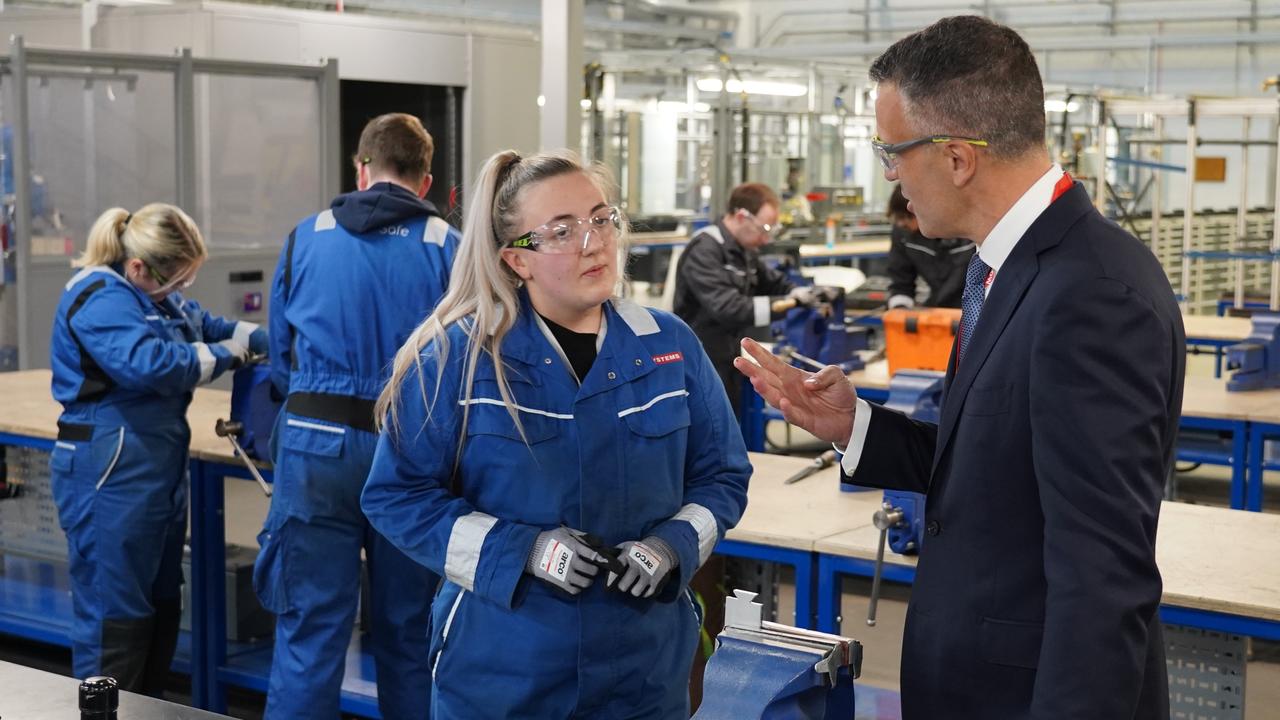Peter Malinauskas tours UK subs shipyard and declares ‘this isn’t the car industry 2.0 – it’s much more transformative than that’
Peter Malinauskas says the nuclear submarines project will be far more complex and transformative for SA than the car industry, requiring generations of skilled workers.

An awestruck Premier Peter Malinauskas has declared the challenge of building nuclear-powered submarines far greater than forging the car industry after being stunned by the “overwhelming size and scale” of a major UK shipyard.
In an interview with The Advertiser after a lightning visit to the Barrow nuclear submarine yard, Mr Malinauskas said it would be irresponsible of him not to acknowledge the scale of SA’s challenge to produce vast numbers of skilled workers.
A Submarines Academy for Skills and Knowledge, attached to the BAE Systems Barrow shipyard, teaches 2000 vocational and degree-based apprentices at any one time – comprising about 10 per cent of the 11,000-strong workforce.
Unveiling the AUKUS submarine plan in San Diego on Tuesday, Prime Minister Anthony Albanese likened the scale, complexity and economic significance to the Australian car industry’s creation after World War II.
But Mr Malinauskas said this was “comparing apples with oranges”, because nuclear submarine construction was “a whole other level of complexity”.
“The car industry was producing a consumer product aimed to be affordable. This is producing the most complex machine ever built in human history,” he said.
“They are very different things in scale and scope but also ability to transform an economy.”
Mr Malinauskas, who talked to electrical and drafting apprentices at the skills academy, said he had been struck by the number who had multiple family members working on the Dreadnought and Astute submarine construction.
“That, in some respects, speaks to the challenge that we have in South Australia, because we don’t yet have that. We need to develop that culture,” he said.
“We need to develop that permanent sense of pride that families have in having people that work on this endeavour. So we’ve got a long way to go.
“It would be irresponsible of me to not acknowledge, having seen what I’ve seen today, the size of the challenge in front of us, but nothing that we’re not capable of.”

In a program based on a UK model to generate skilled workers for the defence industry, Mr Malinauskas on Friday (London time) unveiled a university degree apprenticeship pilot program.
A software engineering degree apprenticeship will enable students to earn while they learn, in a partnership with UniSA and the Australian Industry Group and backed by $450,000 in state government funds over three years (further details below).
BAE Systems Australia employs more than 100 software engineers in SA and expects to double that number within a few years.
The Barrow yard has been making nuclear submarines since 1960, after the UK inked a deal to share US technology in 1958.
The 152-year-old shipyard has more than 11,000 workers – employing nearly 20 per cent of the town’s population of 60,000. Last year alone, 2500 people were recruited to the shipyard.

A second skills academy campus is planned in the Barrow-in-Furness town to cater for expanded demand.
Welding apprentice Grace Needham, 17, has an uncle working at the yard and many of her friends entered the workforce straight from school.
“It’s just so much work that they’re going to have for so many years and I just think it’s definitely worth saying you were a part of doing it,” she said.
Electrical apprentice Erin Sanders-Shaw, 20, told Mr Malinauskas of workers’ pride at being part of a national enterprise.
“I know quite a few people who do go to the launch of the boat just to go ‘I worked on that’,” she said.
Mr Malinauskas told The Advertiser the Barrow yard visit reinforced the importance of having the planned Adelaide skills academy connected to the community and continuously producing graduates.
The yard’s submarine production dipped almost to a standstill after the end of the Cold War in the early 1990s until 2004, creating a “valley of death” for jobs and skills when surface ships were built instead.
“The cost of starting it up again was far greater than the savings made through the turn-down. In other words, once this starts, it doesn’t stop and building up the workforce has to be a continuous effort,” Mr Malinauskas said.
Barrow MP Simon Fell told the Premier of the need for an investment program on roads, schools and other infrastructure to help attract and retain workers.
Mr Malinauskas told The Advertiser the Lefevre Peninsula road to the Osborne Naval Shipyard would have to be equipped to handle “thousands upon thousands of more vehicle movements ... and that is just the most simple of examples”.
SA’s housing shortage intensified the need to act to accommodate thousands of submarine workers, he said, insisting this was one of the drivers behind the largest single release of residential land in the state’s history, revealed in February.
In a joint press conference with Mr Malinauskas at the Barrow yard, UK Defence Procurement Minister Alex Chalk said his nation was “absolutely clear” that SA would meet the challenges of developing a skilled workforce to produce AUKUS submarines at Osborne.
“We will play our part in supporting you and the enthusiasm that exists here in Barrow to help on that enterprise is clear,” he said.
“But … this is not a one-way street. We recognise there’s a huge amount of expertise in South Australia which we will benefit from here.
“Being more than the sum of our parts is ensuring that we have a combined industrial base, a combined supply chain – that’s what creates the resilience that allows us to develop our submarines today (and) you to develop your submarines.”

SUBS SKILLS FAST-TRACKED
A university degree program enabling students to learn while working in defence industry will be accelerated ahead of Adelaide construction of nuclear-powered submarines.
In a pilot program, the University of South Australia will establish a software engineering degree apprenticeship, which enables students to earn while they learn.
UniSA will design, develop and co-deliver the course with employers, backed by a partnership with the state government and the Australian Industry Group.
Premier Peter Malinauskas unveiled the scheme in London on Friday, announcing $450,000 over three years.
This will accelerate the program, enabling the first intake of software engineers in 2024.
Mr Malinauskas said he had been impressed by degree apprentices at work at BAE Systems’ submarine shipyard at Barrow-in-Furness on Thursday.
“This is exactly the sort of opportunity we should be exploring to rapidly increase the skill levels in our defence workforce as we prepare to build the most complex machines on earth,” he said.
“Degree apprenticeships are a way people can both earn and learn, receiving higher education qualifications, while gaining experience in the workplace.
“The UK evidence suggests this is a way we can also broaden and diversify our workforce, which we will absolutely need to do to deliver the massive AUKUS undertaking.”
Degree apprenticeships in the UK are said to have high graduate retention and completion rates.
They also are considered to have increased diversity by attracting more women and others who might not have considered a traditional degree.
At the Barrow yard, the so-called early years workforce is 32 per cent female, compared to the 20 per cent UK defence industry average.
BAE Systems Australia employs more than 100 software engineers in SA and expects to double that figure in the next few years.
Under the new program, graduates get a Bachelor of Software Engineering (honours) through university and workplace learning.
Barrow degree apprenticeship worker Chloe Dunn, 22, is studying project management.
Asked the reasons for her choice by The Advertiser, she said: “I think it was the opportunity to be able to do my degree and do the academic side but also have the learning on the job and my placements, whether it be in a five-year-long scheme, I managed to get lots of six-month lessons out of it and a lot of skills and competencies,” she said.
More Coverage
UniSA vice chancellor David Lloyd said it was critical that his institution played a major role in producing highly skilled graduates for defence, particularly nuclear-powered submarine construction.
Ai Group SA head Jodie van Deventer said degree apprenticeships opened professional career opportunities to people who might not have considered full-time study.
“Bold new models to develop the skills required for the shipbuilding program are timely. The degree apprenticeship model, proven in the UK, is an important addition to our high-end skilling opportunities,” she said.
Originally published as Peter Malinauskas tours UK subs shipyard and declares ‘this isn’t the car industry 2.0 – it’s much more transformative than that’






